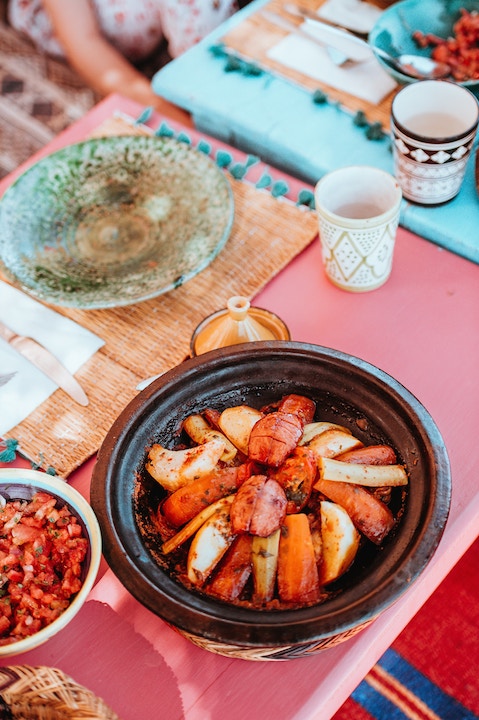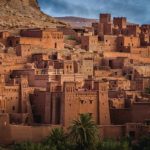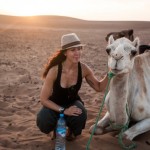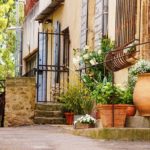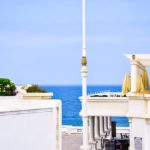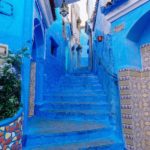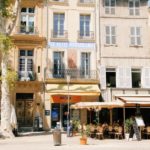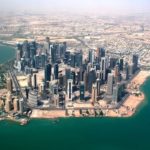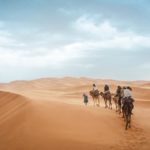Bonjour, Morocco: Journeying to a Magical Land of Contrasts
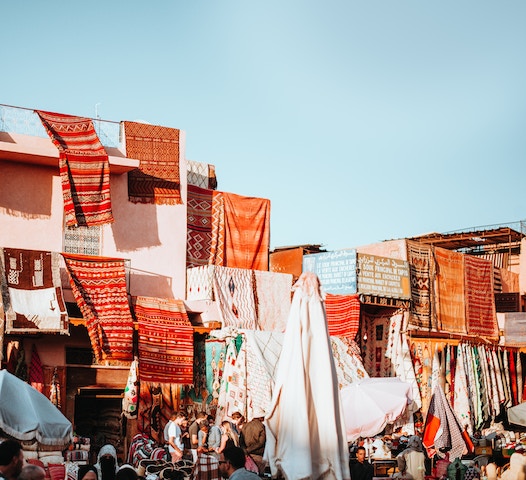
What I loved most about Morocco was that it was a land of juxtaposition. A magical place, no doubt, but a study in contrasts every step of the way.
Marrakech is a dry city, almost the colour of red clay, and the Atlas Mountains can be seen in the distance. Having just left Canada, the land of ice and snow, for a 10-day tour of Morocco, I was immediately struck by the orange trees throughout the city. Amidst the arid, clay cityscape, beautiful lush green foliage with globes of orange lined the sidewalks, roads and driveways.
My first day, a tour guide took me to Djamaa el Fna, the old city square and heart of the medina. It is a vast expanse of market stalls, street vendors, restaurants and snake charmers, all beautifully surrounded by rose-coloured old brick buildings of the medina, with entrances into the labyrinthine souks that meander for miles in all four directions of the square.
Amidst the arid, clay cityscape, beautiful lush green foliage with globes of orange lined the sidewalks, roads and driveways.
Having travelled throughout the Middle East, I expected Morocco to have a similar flavor to other Arab countries I had been to. I was unaware that much of North Africa including Morocco had never been part of the Ottoman Empire. In Marrakech and throughout Morocco, the architecture, culture and cuisine are distinctly North African. For example, the mosques did not have domes; most were angular structures with minarets shaped like tall rectangles rather than round turrets. Arabs were in fact relative newcomers to this region – the indigenous people of Morocco are the Berber.
Although Western clothing is very popular and worn by men and women, the traditional dress seen throughout the country was the djellaba, a Berber-influenced long dress with full sleeves, a pointed hood attached, and usually a zipper down the front. This outfit was worn by both genders. The fabric was usually a dark brown or dark blue heavily twilled cotton or wool.
That first morning, as my guide took me through the orange-red alleyways of the medina, I saw many women out and about their day. Some wore Western-style clothing, while others either wore the djellaba, or, long dresses and overcoats with hijabs typically worn by Muslim women.
The city was still waking up. A woman dressed in a long, orange overcoat and a black headdress to cover her hair was walking toward me in one of the narrow cobbled streets in the old city. She was looking straight ahead but as we passed each other, she glanced in my direction and said, “Bonne journee,” “Good morning” in French.
And thus began my love affair with the French language. Of course, Arabic could be heard throughout the country. But my first morning in Marrakech, the young woman reminded me that Morocco had once been a French colony – or, more accurately, a French “protectorate.” All of the street signs are in French, Arabic and English, and the public schools still use the French curriculum. Most Moroccans speak both French and Arabic, and it was not unusual to walk into a shop or restaurant and be served in French, or the language of your choice.
The French I heard in Morocco, though, was distinct and nothing at all like the Canadian-accented French I was used to.
In Canada, French is one of our official languages. Although I am neither bilingual nor fluent in French, I grew up hearing French around me, and learned basic core French in elementary and high school. The French I heard in Morocco, though, was distinct and nothing at all like the Canadian-accented French I was used to. It was beautiful, melodic, almost like music to my ears — particularly in a part of the world where I did not expect to hear it (out of my own ignorance, of course).
The rest of the trip I was met with similar contrasts and surprises. These all added to the magical quality of this dazzling land. The red dry clay of Marrakech gave way to the sparkling white walls of Casablanca (which literally means “white house” in Spanish). Later, the ancient city of Fez appeared to me as buildings stacked against each other like a wedding cake iced in buttercream. These were set against occasional bursts of red and gold of the vats of coloured dyes in the leather district.
From the sunny, glistening and comfortable climate of these ancient cities, imagine my surprise when I found myself in the middle of a snowstorm while crossing the ice-capped Atlas Mountains. The snow was so bad that one of the highways closed its passage. Yet 24 hours later, I was sitting on a camel, trekking through the golden sands of the Sahara Desert to an overnight desert camp called “Chez Brahim.” The French influence, surely!
Throughout my time in Morocco, I was pleasantly met with many opportunities to practice my hitherto long-dormant French language skills, with shop owners, passersby (strangers always said “bonne journee” or “bonjour” as they passed one another) and taxi drivers. Menus in restaurants were in French and Arabic. I remember stopping in a small town called El-Rashidieh. I wandered up to a window-stall boulangerie, and ordered a pastry.
I left Morocco with a new zest for the French language, and since then, I have taken several French-language classes, even travelling to Montreau, Switzerland for a one-week intensive course.
The French I heard in Morocco, though, was distinct and nothing at all like the Canadian-accented French I was used to.
I could not leave Morocco, though, without taking another piece of the culture home with me. Mint tea, or thé à la menthe, is particular to North Africa and was served all day, everywhere. Moroccan mint tea is a green tea poured over fresh mint leaves and loaded with sugar. The aroma was intoxicating. It is served in tall glasses, and as it is poured, the pot is lifted away from the glass so that bubbles form as the liquid lands.
I am not a tea drinker, but to me, this drink was simply the best elixir I ever had – refreshing first thing in the morning, or after a long, feet-aching day of sightseeing. It was another unique Moroccan tradition, as coffee is more prevalent in most Arab-speaking cultures due to the Ottoman influence.
The sights and sounds of Morocco still live on in my memory. Dry red clay, orange blossoms and bougainvillea; the sun hitting creamy white castles, and snow-capped mountains; the Arabic call to prayer heard amongst French proverbs and idioms; ice and snow meeting with camels dancing in Saharan sands….so many juxtapositions, so much magic! Au revoir, I said to this beautiful land as I flew away. Until we meet again!
Photo credits for Bonjour, Morocco: Journeying to a Magical Land of Contrasts by Unsplash.

